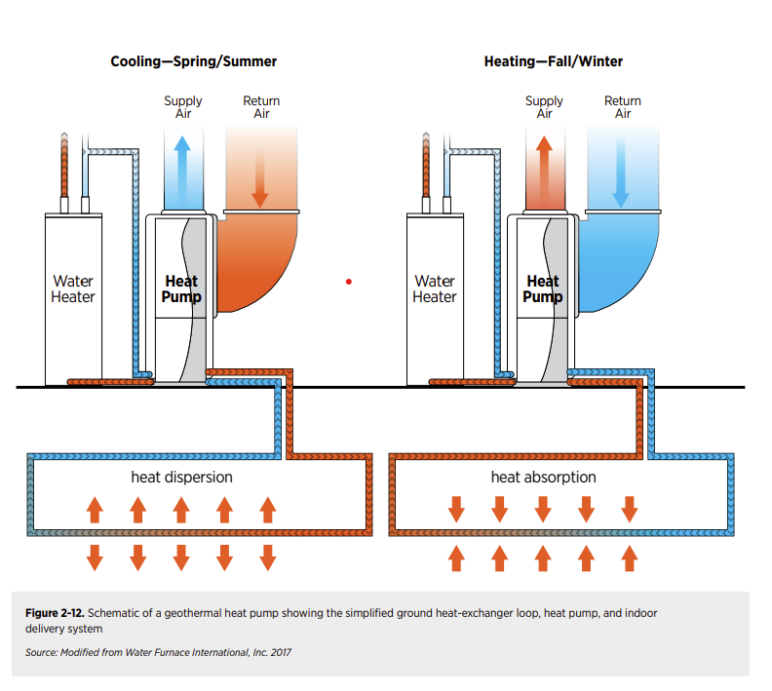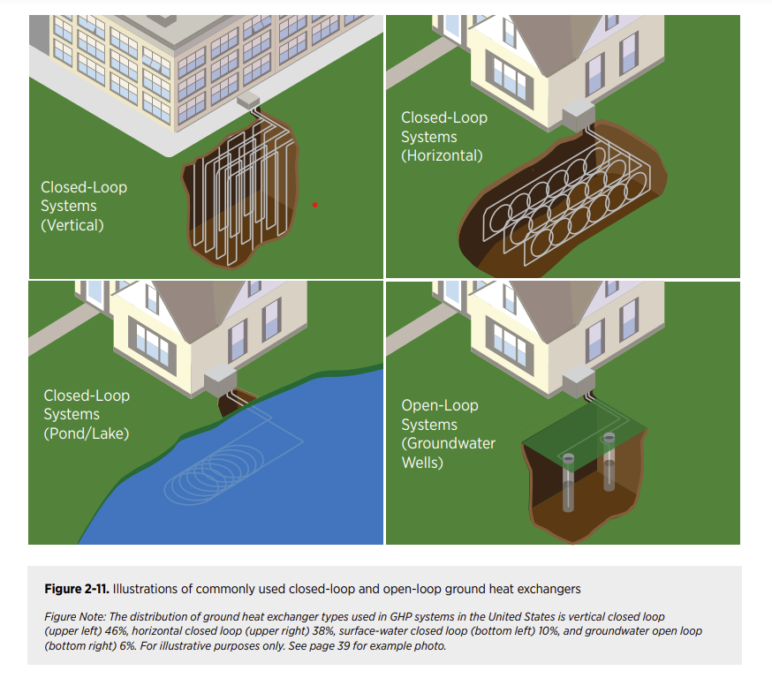Takeaways
Buildings are one of the top greenhouse-gas-emitting sectors across Cascadia, in part due to their reliance on gas for heating, cooking, water heating, and other uses. More than 2 million homes in Cascadia are connected to the gas system.
Meanwhile, gas utilities have no realistic decarbonization plan and are spending millions to prop up gas and prolong the lifespan of gas infrastructure.
“GeoNetworks,” neighborhood-wide networks of ground source heat pumps, are a promising idea to transition homes away from gas while offering gas utilities a credible climate strategy.
Gas utilities in Massachusetts and New York are already piloting GeoNetworks.
Policymakers and regulators in Cascadia should make it possible for gas utilities to do the same here. The payoff would be a cleaner, more efficient, reliable, and lower-cost energy system with a longer lifespan to serve residents and businesses across the region.
Find audio versions of Sightline articles on any of your favorite podcast platforms, including Spotify, Google, and Apple.
To meet Cascadia’s climate goals, we will need to stop burning natural gas to warm our homes, cook our food, dry our clothes, and heat our water. Buildings emit the second-highest level of greenhouse gas emissions of any sector in both Oregon and Washington and the third-highest in British Columbia, in large part because they burn so much gas.1requiring that new buildings be gas-free.
But two major questions loom: how do we transition the more than 2 million homes in Cascadia that are already connected to the gas system?2
Today, in the absence of a plan, politically powerful, deep-pocketed utilities are spending billions of dollars to prolong the lifespan of their gas infrastructure. They are spreading climate falsehoods and trumpeting faux decarbonization ideas like hydrogen for home heating and “renewable natural gas.”
In a small but growing number of communities across North America, though, gas utilities, labor groups, and climate hawks together are exploring an idea that could answer both of these questions: networked ground source heat pumps (I’ll call the idea “GeoNetworks” for short).3
So far, only a few states on the US East Coast are exploring this transformation of gas utilities. In Cascadia, no utility has yet tested GeoNetworks. And only British Columbia even has the legal framework that would allow utilities to do so under a regulated model; an affiliate of the province’s main gas utility, FortisBC, could immediately break ground on the idea. Meanwhile, leaders in Oregon, Washington, and other Cascadian states would be smart to remove regulatory obstacles and allow utilities to pilot GeoNetworks in those states, too.
Northwest gas utilities are hyping false decarbonization solutions while spending more than $1 billion to replace aging gas pipes
Gas utilities are fighting climate progress like their lives depend on it. Which of course, they do, barring a new business model.

Gas utilities across Cascadia are hard at work touting purported climate solutions that are dangerous, unrealistic, and expensive. They are promoting hydrogen for home heating, a hazardous and inefficient solution. They are promising to replace gas with “renewable natural gas”—methane that leaks from landfills or industrial agriculture—at likely impossible volumes. They are challenging climate laws in court and using ratepayer money to spread misinformation about gas, including to Oregon schoolchildren.
In other words, gas utilities are fighting climate progress like their lives depend on it. Which of course, they do, barring a new business model. Gas-only utilities like Cascade Natural Gas (Cascade) and NW Natural are staring down an especially precarious future. Unlike combination gas-and-electric utilities like Puget Sound Energy (PSE) or Avista, which will grow their electric businesses as electrification takes off, gas-only companies stand only to lose.
On top of their climate obstructionism, Northwest gas utilities are spending big to replace aging gas pipes. Indeed, they are planning to replace hundreds of miles of pipes, and ratepayers will need to pay for it.45
GeoNetworks could clean up buildings while leveraging gas utilities’ scale and expertise
Gas utilities are continuing to install infrastructure that will remain in the ground well beyond 2070, more than 20 years after Cascadia, and indeed the world, has committed to zeroing out climate-altering emissions.

To solve gas utilities’ decarbonization dilemma, avoid spending millions (or billions) on near-certain stranded assets, and reduce building emissions efficiently and effectively, a group in Massachusetts, HEET, came up with the novel concept of GeoNetworks.
HEET’s idea is for gas utilities to replace gas infrastructure with a network of ground source heat pumps (GSHPs). GSHPs, also known as geothermal heat pumps, have been around since the 1940s. They take advantage of the Earth’s near-constant temperature just beneath the surface to pull heat from the ground in the winter and store it in the summer. (The ground’s temperature in the United States averages between 50 and 60 degrees Fahrenheit year round, measured 30 feet down. See the appendix for a more detailed explanation of GSHPs.)
GSHPs offer several benefits compared with other home heating and cooling systems, including:
- High efficiency. GSHPs can be up to 460 percent more efficient than the most efficient gas furnaces and about 80 percent more efficient, on average, than air source heat pumps.6 This efficiency lessens the impact on the grid of widespread electrification of heating and cooling.
- Zero emissions. GSHPs run on electricity and emit no carbon directly, unlike gas furnaces. If the electricity powering the heat pump is carbon-free, then so too is the entire GSHP system.
- Low operating costs. GSHPs can lower homeowners’ monthly energy bills by eliminating gas payments or reducing electric bills when replacing low-efficiency electric resistance systems.
GSHPs already are heating and cooling buildings in the Northwest, including at Highland Middle School in Bellevue, Washington; the Rainier Beach Community Center & Pool in Seattle; several communities of townhomes in British Columbia; and the Pringle Creek housing community in Salem, Oregon.
But GSHP’s potential is under-tapped. Just 2 million homes in the United States use GSHPs, while 28 million of them could, according to a 2019 study by the US Department of Energy. This low market penetration is largely because installing GSHPs can cost anywhere from $10,000 to $50,000, making them out of reach for most homeowners.7
These interconnected GSHPs—the GeoNetwork—could spread from neighborhood to neighborhood, ideally beginning with those that have the oldest gas infrastructure that needs to be replaced anyway. This would prevent gas utilities from spending billions on what will soon become stranded assets. And, by working at a neighborhood level, rather than house by house, the GeoNetwork would help avert the so-called “death spiral,” in which an ever smaller group of customers (likely low-income homeowners and renters) is stuck paying an ever greater share of gas infrastructure costs. That’s because if an entire neighborhood can be disconnected from the gas system, remaining customers no longer need to pay for the continued upkeep of that neighborhood’s gas infrastructure, as they would if houses scattered haphazardly across a city disconnected.
Plus, the network would become more efficient as it grew, taking advantage of the diversity of energy needs of different buildings. Grocery stores, for example, could provide waste heat from their refrigerators to the network in winter to heat nearby homes and businesses.
Intrigued, several gas utilities in the US Northeast are testing the idea. In 2021, the Massachusetts Department of Public Utilities approved pilot plans for GeoNetworks by both Eversource and National Grid. In September 2022, Eversource started drilling for its 45-building project in Framingham, Massachusetts. The 2022 Massachusetts legislature also allocated $5 million for further research into the idea. Farther south, New York passed the “Utility Thermal Energy Networks and Jobs Act” in 2022. The law, which is the first of its kind in the United States, directs the state’s Public Service Commission to develop a regulatory framework for the idea and requires the seven largest investor-owned utilities in the state to each submit at least one pilot project to the commission for review.
GeoNetworks offer benefits other gas decarbonization ideas do not
GeoNetworks seem promising, but do they make more sense than other ideas for gas utility decarbonization? And, more importantly, should we even be trying to save gas utilities at all? Indeed, the seemingly simplest building decarbonization solution ends with gas companies’ demise. Cities and states would decommission gas infrastructure neighborhood by neighborhood, reducing gas utilities’ customer counts, while introducing new policies and regulations to protect and support customers and utility workers in the transition. Ultimately gas companies would no longer be in business, except perhaps for environmental remediation or safety monitoring.
Gas utilities, though, with their deep pockets and vast political influence, are not going down without a fight. In Oregon and Washington alone, they have annual revenues of $2.6 billion and in 2021 made political contributions of $11.7 million.8
Thanks to Robin Briggs for supporting a sustainable Cascadia.
Our work is made possible by the generosity of people like you.
A savvy strategy would make decarbonization the companies’ surest path to success.
One approach could be for gas utilities to install, lease, or sell electric appliances that help decarbonize buildings, such as heat pumps. For example, Vermont’s gas utility, VGS, is piloting a program to install heat pump water heaters.
This “behind-the-meter” model may make good climate sense, but it doesn’t leverage utilities’ existing strengths, and it may trespass on others’ markets, giving regulators pause. Many third-party companies could offer similar services in a competitive market, and indeed, companies across Cascadia already do sell or install these appliances.
GeoNetworks, by contrast, would both decarbonize buildings and leverage gas utilities’ existing advantages, not least of which are their:
- Scale and existing rights-of-way. They own about 70,000 miles of distribution pipes across Cascadia.9
- Workforce. They employ about 6,500 workers, many of whom already have the skills needed to install GeoNetworks.10
- Customer relationships and billing systems. They serve more than 2 million residential customers today.
- Access to capital.11
Plus—and this point is critical—the regulated utility financial model rewards gas companies in direct proportion to their investments in physical infrastructure. By contrast, a smaller, unregulated company may struggle to recoup the high upfront capital costs of GeoNetworks quickly enough for the model to be financially viable.
GeoNetworks fit under a broader group of thermal energy models. The better-known of these approaches is “district heating,” common in Europe and on university campuses. These differ from GeoNetworks primarily in that they produce hot or cold water at a centralized location and then pump it through pipes to heat and cool dispersed buildings. GeoNetworks, on the other hand, pump ground-temperature liquid (water, or a combination of water and refrigerant) through pipes to buildings, which have their own heat pumps to do the heating and cooling. In most cases, GeoNetworks are likely to beat district heating on cost and energy efficiency, but in some areas, such as in dense city centers, district heating may make more sense. And that’s fine, because gas utilities’ decarbonized future could include operating both GeoNetworks, in most areas, and district heating in downtowns.
Policymakers in Cascadia would be smart to dig deeper into GeoNetworks
Today, most gas utilities in Cascadia couldn’t pilot GeoNetworks if they wanted to. Neither Oregon nor Washington allows utilities to provide thermal energy as a regulated business line. Existing thermal energy providers, which are mostly smaller district heating outfits such as CenTrio (formerly Seattle Steam Company), are exempt from state utility regulation. Gas utilities could try GeoNetworks as an unregulated business line, but they would not enjoy a guaranteed rate of return and would be unable to spread the upfront investment cost over millions of customers.
British Columbia leads Cascadia in having the regulatory groundwork that would allow GeoNetwork utility pilots. Unlike in Oregon and Washington, thermal energy is regulated in the province, and the BC Utilities Commission created a regulatory framework for thermal energy utilities in 2014. It offers a scaled approach. Smaller providers of GSHPs, district heating, and other thermal energy solutions are largely exempt, but companies providing these services at a larger scale are regulated just like gas and electric utilities. While gas companies cannot directly offer thermal energy, they can create affiliates to do so. FortisBC, the province’s main gas utility, has done just that with FortisBC Alternative Energy Services (FAES). But to-date FAES has only installed GSHPs and other thermal energy systems in single-site developments, not in a network model. Fortis could immediately begin to pilot GeoNetworks through FAES.
In Washington and Oregon, processes are in motion that could allow piloting GeoNetworks, too. The Washington Utilities and Transportation Commission is investigating pathways for gas utility decarbonization and will submit a report to the state legislature by June 1, 2023. Oregon’s Public Utilities Commission released a draft of its “Natural Gas Fact Finding” report in April 2022. It’s now working on a revised final draft after receiving near-unanimous criticism from climate hawks for being too dependent on gas industry assumptions and analysis.
As part of these processes, regulators and policymakers in both states would be smart to model the decarbonization potential of GeoNetworks and to remove regulatory barriers to utilities piloting GeoNetworks. This reform could mean expanding the definition of gas utilities to include providers of (renewable) thermal energy, as New York has done, or creating a new, separate regulatory framework for distinct thermal energy utilities, following the example of British Columbia. The former may be preferable, because it would likely make it easier for gas companies to spread the high infrastructure costs of GeoNetworks over all their existing customers and for companies to convert customers from gas to GSHPs. But both models are worth investigating.
In sum, Cascadia is making formidable progress preventing the expansion of its polluting gas system. But it has not yet figured out how to equitably and efficiently transition the more than 2 million households in the region that are hooked up to gas. In the meantime, gas utilities are doubling down on faux climate solutions. GeoNetworks could offer a way out of this problem by creating a realistic decarbonization strategy for gas utilities while providing Cascadians with one of the most climate-friendly and efficient heating and cooling systems on Earth.
Table 1: Northwest utilities plan to spend more than $1 billion to replace aging pipes over the next decade
| Estimated miles still to be replaced | Estimated pipe replacement cost | |||||
| OR | WA | Total | OR | WA | Total | |
| Avista (by 2030) | 145 | 177 | 322 | $173,318,455 | $128,598,534 | $301,916,989 |
| PSE (by 2033) | n/a | 228 | 228 | n/a | $588,400,000 | $588,400,000 |
| Cascade (by 2033) | 75 | 107 | 181 | $86,310,686 | $126,341,012 | $212,651,698 |
| Total | 731 miles | $1,102,968,687 | ||||
Methodology: PSE and Avista provide information on the miles they have already replaced as part of the PRP and totals that they plan to replace. Sightline found the difference to estimate the number of miles still to be replaced and used average historical costs per mile to estimate remaining costs. Cascade does not provide information on total miles it plans to replace, so Sightline estimated the remaining miles to be replaced and costs per mile based on the company’s historical averages.
Appendix: Overview of ground source heat pump (GSHP) technology
All types of ground source heat pumps (GSHPs) rely on three primary components (see figure 2 below):
- Loops in the ground known as heat exchangers. Water and/or refrigerant circulates through the loops and picks up or dispels heat, depending on the season.
- A heat pump that pulls the heat from the liquid in the pipe loop and supplies it to a home, in winter, or pulls heat from the home and puts it in the pipe loop, in summer.
- An indoor energy delivery system, such as radiant in-floor heating tubes, a water heater, or a forced-air handler, just like the ones that many homes already have.
Figure 1: Components of a ground source heat pump system

The loops in the ground (heat exchangers) can be installed either vertically (when there is not much land available) or horizontally. They can also be set up as either “closed-loop” systems, in which water/refrigerant runs continually through the loops) or “open-loop” systems, in which water from a pond, lake, or well circulates and returns to the source. The most common types of GSHPs are vertical, closed-loop systems. A simplified diagram of these types is below:




Comments are closed.